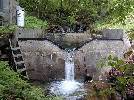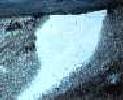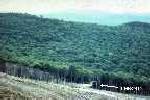OVERVIEW OF THE ECOLOGICAL BACKGROUND
History:
The USDA Forest Service established the Hubbard Brook Experimental Forest (HBEF) in 1955 as a hydrologic
research center. In the early years, scientists focused largely on assessing the impacts of forest management on water yield, water quality,
and flood flow. In 1960, additional scientists become involved, and the Hubbard Brook Ecosystem Study (HBES) began. HBES scientists
developed the small watershed concept, which at the time was a new approach to ecosystem science in which scientists studied and
manipulated entire watersheds to learn more about elemental flux and cycling.
The Hubbard Brook flows through New Hampshire's White Mountain National Forest and drains a range
of small mountains. The tributaries of Hubbard Brook form a set of discrete watersheds, separated by mountain ridges. Six of the south-facing
watersheds are similar in size (~10-40 hectares), have relatively uniform characteristics (e.g., soils, vegetation, geology, atmospheric deposition),
are lined with watertight bedrock and glacial till, and are representative of the surrounding northern hardwood forest that comprises much of the
northeastern United States and Canada. The uniformity allows for comparisons to be made between watersheds, the watertight bedrock makes
quantitative hydrologic and elemental budgets possible, and the similarity to surrounding ecosystems allows for extrapolations of results to a
broader area. For these reasons as well as many logistical ones (e.g., ownership and administrative control), these watersheds are ideal for
conducting long-term ecosystem experiments.
In fact, experimental manipulation of whole watersheds has long been a focus of research activities at the
Hubbard Brook Experimental Forest. By establishing two reference watersheds and then comparing short- and long-term responses to manipulations
of the four adjacent treatment watersheds, HBEF scientists have been able to obtain quantitative information on relevant environmental issues,
test research hypotheses, and develop thorough knowledge of ecosystem patterns and processes.
The first whole-watershed experiment (1965) is the focus of this activity, and involved the deforestation
of "Watershed 2" to examine hydrologic and elemental watershed output. Though they are not considered in this activity, three other watersheds have
also been manipulated at the HBEF. The second manipulation, beginning in 1970, examined the effects of strip-cutting on forest processes, water
yields, and elemental budgets. In the early 1980s, researchers clear-cut an entire watershed to examine how commercial logging affected watershed processes.
More recently, calcium has been added to an entire watershed in an experiment examining long-term effects of acid deposition on northern hardwood
forests. Scientists at the HBEF continue to monitor these watershed experiments, conduct hundreds of additional experiments and long-term
monitoring efforts, and plan for future watershed manipulations on north-facing slopes.
The Watershed 2 Experiment:
As the HBES was first getting underway, the northeastern states were experiencing a drought and many
communities were suffering from water shortages. Considering the role transpiration plays in forest ecosystem water budgets, hydrologists and
forest managers were curious about the effects deforestation would have on downstream water supplies.
One of their specific hypotheses was that cutting down trees would lead to increased streamflow and
corresponding increases in downstream reservoirs. At the same time, cooperating ecosystem scientists were interested in studying how
entire watersheds respond to major disturbances. Combining their interests, scientists designed an experiment in which an entire watershed
would be deforested. The team of scientists involved would then study streamflow, element and nutrient cycling, and soil and vegetation responses.
The experiment began in December 1965, as all trees in experimental Watershed 2 were cut and left on top
of the snow (to minimize disturbance). In the summers of 1966, 1967, and 1968, two herbicides were applied to the entire watershed to prevent the
regrowth of any vegetation. Applying the herbicides allowed hydrologists to answer the water flow hypothesis discussed above and enabled
collaborating scientists to study element cycling. Scientists believe that the herbicides were added in such low concentrations that it did not negatively
affect organisms in the watershed or downstream.
In this activity, students will determine whether streamflow results support or refute the hypothesis that
deforestation leads to increased streamflow. To do so, they will examine short- and long-term streamflow data from Watershed 2 and Watershed 3
(reference). Streamflow has been measured constantly in these watersheds since stream weirs were installed in the late 1950s.
Archival Photos (note: click on any thumbnail to see the full size image):
| Figures 4A-D. Series of four photos taken near the top of Watershed 2. All photos were taken at the same point, looking in the same direction in: | |||
| 1969 | 1970 | 1971 | 1972 |
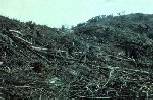 |
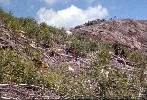 |
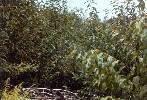 |
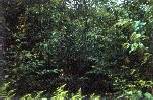 |
Long Term Ecological Research at the Hubbard Brook Experimental Forest:
In 1980, the National Science Foundation established the Long Term Ecological Research network (LTER) to support research on long-term ecological phenomena in the United States. Since that time, the LTER network has grown to 24 sites and over 1,100 scientists, graduate students, and research technicians. The sites represent several different biomes and are located across the United States and Antarctica. The Hubbard Brook Experimental Forest joined the network in 1987, with an ongoing objective to develop a better understanding of the response of northern hardwood forest ecosystems to large-scale disturbances such as deforestation or acidic deposition.
Although Hubbard Brook and the other sites have their own unique interests, as LTER sites they all focus in part on five core research topics. Scientists at the central office help coordinate these research activities, encourage inter-site collaborations and synthesis of results, and strive to meet the LTER central mission. This activity demonstrates the importance of long-term data collection and the subsequent significance of the LTER network. For more information, visit the LTER website at www.lternet.edu.
LTER Core Research Topics:
-
1. Pattern and control of primary production;
2. Spatial and temporal distribution of populations selected to represent trophic structures;
3. Pattern and control of organic matter accumulation and decomposition in surface layers and sediments;
4. Patterns of inorganic inputs and movements of nutrients through soils, groundwater and surface waters; and
5. Patterns and frequency of disturbances.
LTER Mission:
-
1. Understand ecological phenomena over long temporal and spatial scales;
2. Create a legacy of well-designed and document long-term experiments and observations for future generations;
3. Conduct major synthetic and theoretical efforts; and
4. Provide information for the identification and solution of ecological problems.
References:
Hornbeck, J.W., M.B. Adams, E.S. Corbett, E.S. Verry, J.A. Lynch. 1993. Long-term impacts of forest treatment on water yield:
a summary for northeastern USA. Journal of Hydrology 150:323-344.
The Hubbard Brook Ecosystem Study Website. 2003. www.hubbardbrook.org.
